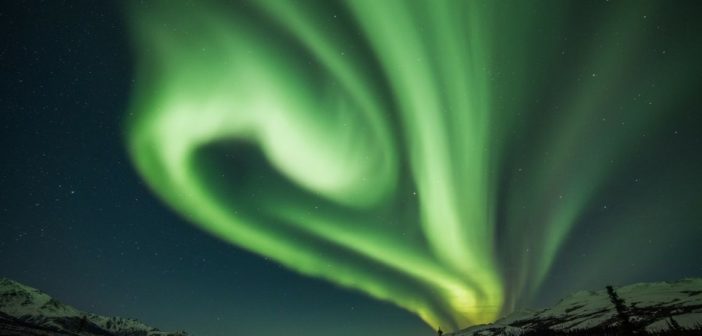Editor’s Note: This week we’re at the virtual 238th AAS Meeting. Along with a team of authors from Astrobites, we will be writing updates on selected events at the meeting and posting each day. Follow along here or at astrobites.com. The usual posting schedule for AAS Nova will resume on June 14th.
Welcome Address (by Luna Zagorac)
The 238th Meeting of the American Astronomical Society was opened by President Paula Szkody, who acknowledged that the meeting was originally scheduled to take place in Anchorage, Alaska. While Dr. Szkody acknowledged many people are missing the in-person interactions of AAS meetings, meeting online has allowed more folks to join the summer meetings that would be possible in-person. Dr. Szkody led us through AAS officer and staff changes, progress of AAS publications, changes to prize nomination processes, and more. Finally, Dr. Szkody gave us a quick overview of the schedule of the meeting, and highlighted that another pro of meeting online is the ability to go back and watch overlapping talks. Read on for summaries of the plenaries and press conferences of Day 1 of #AAS238!
Fred Kavli Plenary Lecture: A New Era of Measuring Magnetic Fields in Galaxies (by Mia de los Reyes)
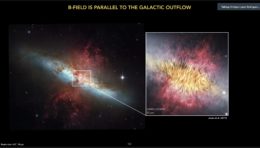
In the extreme starburst galaxy M82, energetic galactic winds caused by extreme bursts of star formation can drag the magnetic field out of the galactic plane! Click to enlarge. [López Rodríguez 2021]
This is in part due to the impressive efforts of facilities like the Stratospheric Observatory for Infrared Astronomy (SOFIA). SOFIA can observe magnetic fields by measuring the polarization of light in far-infrared wavelengths. This polarization is caused when dust grains align along magnetic field lines; light scattered by the aligned dust grains then gets polarized. Using this technique, Dr. López Rodríguez and his collaborators have been able to produce beautiful maps showing magnetic field strength and structure around nearby galaxies. From these maps, we’ve been able to determine that in spiral galaxies, large-scale magnetic fields tend to be ordered and follow the spiral arms. However, small-scale dynamo processes (like turbulence from star formation or galaxy interactions) can make the magnetic field more chaotic on local scales. Other phenomena might also affect galactic magnetic fields — for example, strong outflows caused by extreme starbursts can drag a galaxy’s magnetic field away from the galactic plane!

In spiral galaxies, magnetic fields tend to be ordered and follow large-scale structures like spiral arms (left). But small-scale phenomena, like turbulence from star formation, can disrupt the magnetic fields, causing them to be more tangled! [López Rodríguez 2021]
Interview of Enrique López Rodríguez by Luna Zagorac
Live-tweeting of the session by Mia de los Reyes
Press Conference: Stars & Clusters (by Macy Huston)
The first press conference presentation of AAS 238 was given by James Schroeder (Wheaton College, Illinois) & Gregory Howes (University of Iowa), who explored the connection between aurorae and Alfvén waves. Aurorae are caused by disturbances in Earth’s magnetic field which accelerates charged particles. These, in turn, perturb atmospheric particles, emitting the beautiful design we often call the northern lights. Alfvén waves are a type of disturbance in magnetic fields where ions oscillate on magnetic field lines, and they have been detected during auroral events. The team used the Large Plasma Device to produce Alfvén waves in a lab, and found that electrons moving at nearly the speed of the waves would “surf” them and be accelerated. So, Alfvén waves can cause the acceleration of electrons which causes aurorae! Press release
Next, Emily Mason (USRA & NASA Goddard SFC) discussed the jet/coronal mass ejection continuum. Solar eruptions seem to exist on a spectrum, but we are most familiar with jets (small-scale ejections of plasma from a star) and coronal mass ejections (significant expulsions of plasma and magnetic fields from a star). The 2016/03/13 solar event appears to be the missing link between these two categories. In the observations, we see a “failed eruption” that collapses before material exits the Sun. The mechanism behind this event is not yet fully understood, and magnetohydrodynamic simulations are underway. Press release
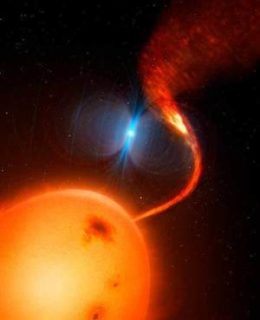
An illustration of a fast-spinning, magnetic white dwarf rejecting the donor gas in the cataclysmic variable known as J0240. [Mark Garlick]
Kris Davidson (University of Minnesota) presented Eta Carinae’s evolution over time as a “supernova imposter.” Supernova (SN) imposters, or giant eruptions, look like SN explosions, but their stars somehow survive. While several of these have been seen, Eta Carinae is the only one near enough to study in detail. It was one of the brightest stars in the sky in the mid-1800s and ejected 10–20% of its mass. Stars undergoing this process are expected to return to their normal states in ~40 years, but Eta Carinae has been weird for almost 200 years. It was discovered that the star has a hot but smaller companion star, and the pair’s colliding winds make the recovery process unsteady. The star has become brighter than its nebula and is expected to eventually ionize its nebula, dramatically altering its appearance and properties.
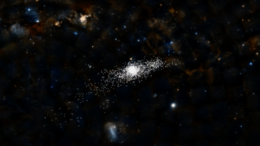
Representation of open cluster NGC 2516, which a new study suggests is ~1,500 light-years from tip to tip, appearing as 40 times the width of the full Moon in our sky! [Luke Bouma, Princeton University]
YouTube recording of the session on the AAS Press Office channel
Live-tweeting of the session by Macy Huston
NASA Town Hall (by Sabina Sagynbayeva)
Paul Hertz, the Director of the Astrophysics Division in the Science Mission Directorate (SMD) at NASA, told us about the present and the future of NASA’s missions. He started off by reminding us of one of the most exciting accomplishments of 2021: the landing of Perseverance! He also reminded us of other major accomplishments: Parker Solar Probe’s images are the first to show the planet’s dust ring for nearly its entire 360-degree span around the Sun; Fermi’s Gamma-ray Burst Monitor detected a short outburst of gamma rays; Fermi’s Large Area Telescope detected GeV photons within minutes of the outburst.

An artist’s illustration of the James Webb Space Telescope, a joint effort between NASA, the European Space Agency, and the Canadian Space Agency. [NASA/JWST]
There are a lot of exciting scientific projects that are coming in the near future, but today Hertz also emphasized DEI, and what NASA does to achieve inclusive and diverse teams. He also spent some time talking about how COVID-19 affected NASA’s missions and also what they have accomplished during the pandemic. So let’s dig into these two topics.
NASA is creating a multi-pronged approach to achieve diversity and inclusion. One example is their web page with NASA-provided wellness resources for its researchers to better maintain a work-life balance. NASA also encourages all interested members of the public to collaborate on citizen science projects. Moreover, Dual-Anonymous Peer Review (DAPR) has been successful in removing some implicit bias towards women scientists, and according to a questionnaire DAPR improved the overall quality of the peer review. NASA is also developing a policy to ensure that the results of its federally funded scientific research are shared openly.
NASA has been in a mandatory telework configuration due to COVID-19 for over one year now. NASA Centers are planning for ramping up onsite activities when the 25% occupancy limit is lifted. SMD is working toward multiple launches scheduled for the fall and winter of this year, including Webb, Lucy, Landsat-9, DART, IXPE, and GOES-T. Hertz also mentioned that government-wide rules allowed the flexibility to continue to pay salaries on a case-by-case basis for researchers, even if they couldn’t work during COVID-19.
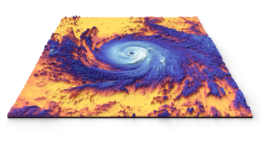
NASA’s work is not all outward looking! The Earth System Observatory will study Earth’s climate system (including events like Hurricane Maria, shown in a thermal image here) to guide research on climate change, disaster mitigation, and improving agricultural processes. [NASA]
Finally, Hertz is stepping down from his position in 6 months but he emphasizes that he has accomplished all his goals. But the message he wants us to hear is: “[Looking at all these future missions], it’s a great time to be an astrophysicist!”
Live-tweeting of the session by Sabina Sagynbayeva.
Plenary Lecture: The Time Is Now: Findings from TEAM-UP Report to Increase the Number of African Americans with Bachelor’s Degree in Physics and Astronomy (by Ellis Avallone)
The first afternoon plenary on day 1 of AAS 238 is all about the findings and lessons learned from the American Institute of Physics (AIP) TEAM-UP report! We covered the release of the report back at AAS 235 in January 2020, where we learned about the factors that lead to African American undergraduate student success in physics and astronomy departments. Tabbetha A. Dobbins (Rowan University), one of the founding members of the TEAM-UP task force, described the formation of the task force and what lessons were learned from it.
The majority of the talk was focused on the 5 factors that TEAM-UP found were essential to African American student success: a sense of belonging, physics identity, academic support, personal support, and supportive leadership and structures. Dr. Dobbins also emphasized the importance of viewing students holistically, not just as students but as whole people with intersecting social identities and experiences. With these 5 factors in mind, Dr. Dobbins moved on to discussing recommendations for departments outlined in the report.
She prefaced the discussion on departmental recommendations by introducing a case study. In the case study, a junior professor is looking to help a Black student who is struggling and isolated. However, the junior professor is unsure of how to help. Dr. Dobbins then described the recommendations made by the report. A key point: these suggestions purposefully do not include recommendations for students, but rather focus entirely on fixing the environments so that minoritized students can thrive.
In the context of the case study, the first recommendation involves creating a culture where everyone is welcomed (i.e. having common spaces within the department, inviting speakers who can discuss the development of a student’s physics identity, and developing informal mentoring relationships). The department should also provide incentives for faculty to support minoritized students, both financially and as mentors; the report found that students who work as teaching or learning assistants are more likely to develop a sense of belonging and physics identity.
To learn more about what you can implement in your department, check out the full report and follow the TEAM-UP task force for updates on the important work they continue to do!
Press Conference: Black Holes & Active Galactic Nuclei (by Susanna Kohler)
For the second press conference of AAS 238, we turned to the ever-mysterious topic of black holes and their host galaxies.
Alexia Lopez (Jeremiah Horrocks Institute, U. of Central Lancashire) opened the briefing with a recent unexpected find: an enormous arc of galaxies spanning a stunning 3.3 billion light-years across the sky. Such large-scale structures in the universe aren’t expected under the cosmological principle, an underlying tenet in the standard model of our universe that states that matter should be distributed homogeneously and isotropically on large scales. Press release
What happens to the active nuclei of galaxies (AGN) — accreting supermassive black holes — as they age? We may now have front-row seats to find out, according to Kohei Ichikawa (Tohoku University)! New multiwavelength observations of the heart of Arp 187 show some expected AGN features, like the presence of large-scale jets, but others are missing, like a central radio core. Ichikawa and collaborators have concluded that Arp 187 represents a “dying AGN” — the nucleus has already shut off, and we’re now seeing only the large-scale relics of its past activity.

Look closely! This XMM-Newton image reveals the many X-ray sources hidden in the XMM-LSS field (full Moon provided for scale). [ESA/XMM-Newton/XMM-SERVS collaboration/Q. Ni et al.]
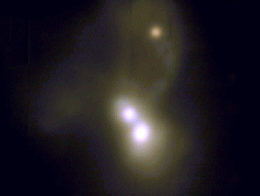
Composite image of the triple galaxy merger. The bottom two sources are the active galactic nuclei; the top source is likely a dwarf galaxy. [VLT/MUSE]
In May 2019, LIGO detected the collision of two monster black holes of ~66 and ~85 solar masses in an event called GW190521. This raised eyebrows, as it’s believed that black holes of ~50–120 solar masses shouldn’t be able to form; stars the right size to form these black holes are thought to explode in something called a pair instability supernova. In our final briefing today, Jorick Vink (Armagh Observatory and Planetarium) introduced a possible explanation for this paradox: if a supergiant star evolves in a very low-metallicity environment, its disk winds would be very weak, preventing it from losing a lot of mass and entering the unstable size range. Such a star could successfully collapse into a black hole like the ones witnessed in GW190521 without first blowing itself apart.
YouTube recording of the session on the AAS Press Office channel
Live-tweeting of the session by Luna Zagorac
Newton Lacy Pierce Prize Lecture: Stargazing and Supergiants: Betelgeuse, Dying Stars, and the Observational Future of Stellar Astrophysics (by Mia de los Reyes)
About a year ago, Betelgeuse became the subject of national attention when it dimmed dramatically, sparking questions about whether it was about to explode. Betelgeuse seems to be back to its normal brightness now (although you can check here for daily updates if you’re worried), and Emily Levesque (University of Washington) assures us that it’s (probably) not going to explode anytime soon. Levesque, the winner of this year’s Newton Lacy Pierce Prize for outstanding research in observational astronomy, finished off the first day of #AAS238 with a brief review of some of the science we’ve learned just from this one fascinating object.

The light curve of Betelgeuse shows a sharp drop in late 2019, known as “The Great Dimming.” [Levesque 2021]
Even if this particular star doesn’t explode in our lifetimes, we still want to know what happens to red supergiants right before they die. To fully understand what happens when the most massive stars in the universe go boom, we’ll need more observations of red supergiants near and far — including Betelgeuse. Fortunately, as Levesque emphasized, complementary observations from upcoming space telescopes and ground-based observatories will help us learn more!
Interview of Emily Levesque by Huei Sears
Live-tweeting of the session by Mia de los Reyes

